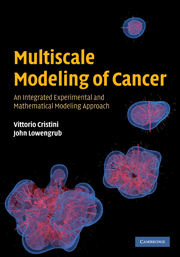Book contents
- Frontmatter
- Contents
- List of contributors
- Preface
- Acknowledgements
- Notation
- Part I Theory
- 1 Introduction
- 2 Biological background
- 3 Continuum tumor modeling: single phase
- 4 Analysis and calibration of single-phase continuum tumor models
- 5 Continuum tumor modeling: multiphase
- 6 Discrete cell modeling
- 7 Hybrid continuum–discrete tumor models
- 8 Numerical schemes
- Part II Applications
- References
- Index
2 - Biological background
from Part I - Theory
Published online by Cambridge University Press: 05 October 2010
- Frontmatter
- Contents
- List of contributors
- Preface
- Acknowledgements
- Notation
- Part I Theory
- 1 Introduction
- 2 Biological background
- 3 Continuum tumor modeling: single phase
- 4 Analysis and calibration of single-phase continuum tumor models
- 5 Continuum tumor modeling: multiphase
- 6 Discrete cell modeling
- 7 Hybrid continuum–discrete tumor models
- 8 Numerical schemes
- Part II Applications
- References
- Index
Summary
In this chapter, we present some of the key biological concepts necessary to motivate, develop, and understand the tumor models introduced in this book. We introduce the molecular and cellular biology of noncancerous tissue (Section 2.1) and then discuss how this biology is altered during cancer progression (Section 2.2). The discussion may be more detailed in some areas than is necessary for the models that we present; the intention is to offer a sample of the rich world of molecular and cellular biology, helping the reader to consider how these and other details may need to be incorporated in the work of cancer modeling. For greater depth on any of the topics, refer to such excellent texts as for molecular and cellular biology and for cancer cell biology.
Key molecular and cellular biology
We focus upon the molecular and cellular biology of epithelial cells, the stroma, and the mesenchymal cells that create and maintain the stroma (Section 2.1.1). Specific and often anisotropic adhesive forces help to maintain tissue architecture (Section 2.1.2). Epithelial and stromal cells have the same basic subcellular structure (Section 2.1.3) and share much in common. They progress through a cell cycle when preparing to divide, can control their entry into and exit from the cycle, and can self-terminate (apoptose) when they detect irreparable DNA errors or other damage (Section 2.1.4). Their behavior is governed by a signaling network that integrates genetic and proteomic information with extracellular signals received through membrane-bound receptors (Section 2.1.5).
- Type
- Chapter
- Information
- Multiscale Modeling of CancerAn Integrated Experimental and Mathematical Modeling Approach, pp. 8 - 23Publisher: Cambridge University PressPrint publication year: 2010
- 7
- Cited by



